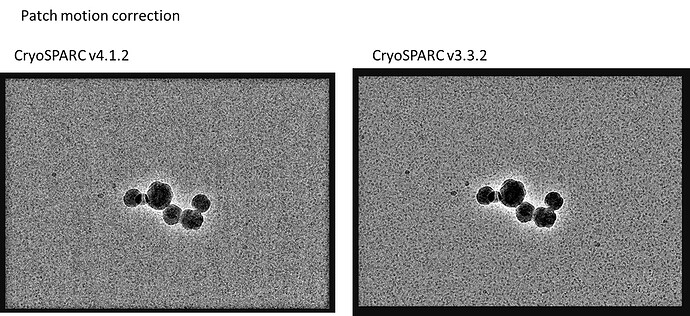Hi, this is Honglei.
Our facillity have updated the cryoSPARC from v3.3.2 to v4.1.2.
When I processed the same set of the data, I found the patch motion correction of v4.1.2 is not as good ad v3.3.2. Please see attached picture for your reference. I used the default parameters to do patch motion correction.
Does anybody meet this problem? The patch motion correction of v4.1.2 results ruined my downstream 2D classification. I cannot find good class as I did with v3.3.2.
Please help. Thank you so much!
1 Like
Aha! Same here, but it doesn’t seem to happen with all datasets, at least for some it seems to be acceptable. Downstream CTF determination gives weird, low frequency waves that put the defocus really off.
I didn’t do a proper comparison as you did, though.
Hi Carlos
My particle size is between 100-200 kDa and around 140 A. The new patch motion correction in version v4 did not perform well as before. For your particles that did not affected, what is the size?
Honglei
Hi Honglei,
Just a bit bigger than yours… ~200 kDa, 180 angstroms. From the FFT plots from Patch CTF job (and also from CTFFIND within CS), the signal from the particles seems too weak as compared to the low frequency signal that appears in the images.
Oh I need to specify that, in my case, the comparison is made with Scipion motion correction - actually MotionCorr2 - which then gives good CTF fitting.
Is the gain flipped? What happens if you manually input a smaller number of knots (say 8,6 like you might use in MC2)? Can you try a B-factor of 300? Also double check total dose and F-crop. Maybe re-import this one movie de novo to make sure the inputs are right (and you can just troubleshoot running this one movie).
Also - is it the whole dataset or specific movies? Do those movies tend to have gold at the edges or ice contamination as in this case? Does this micrograph have some low-res diffraction spikes from the ice? Dose CTF estimation behave different using a resolution range from 20 - 5 instead?
Hi Daneil
The movie was gain-corrected. I tried smaller number of knots but did not help. I did not try other parameters such B-factor and F-crop, as these parameters were the same for v3.3.2 and v4 of cryoSPARC. I re-imported moive, still no improvement.
It happens to the whole dataset, because the 2D classification were very bad with v4 compared with v3.3.2 with the same work pepline. I am not sure if CTF has any problem, but I can directly tell the particle became blur after the patch motion correction. I used the default parameters of patch motion correctoin of V3.3.2 and v4 of cryoSPARC. The difference is very obvious.
Yes, the difference is obvious. What happens if you try those things? And are you sure the gain is oriented right? I can see vertical artifacts in the bad image.
Oh Yes. I just noticed the vertical artifacts in the bad image.
According to our cryoEM manager, my movies were gain-corrected and in mrc format. There is gain in mcr file. So I didn’t specify gain correction file in both v3.3.2 and v4. Is there any problems for that?
So not already gain corrected MRC, but each MRC holds 2 full images?
I don’t know how cryoSPARC handles the included gain image in that case. Usually we use write compressed .tif files and have a single gain reference file. This will be ~8x less space on disk than MRC with included gain, plus it’s wells supported by all the software and makes sure the raw data is unaltered. Someone from the team will have to comment if handling those might have changed between versions.
Is anything different if you flip the gain in Y?
I’m assuming they are prob gain corrected already at the frame level - prob from EPU?
(FWIW Patch Motion in 4.1.x works fine for us, but we also usually use LZW TIFF + separate gain)
Also - what detector was used for the data that gives problems? Assuming K3 based on the aspect ratio?
